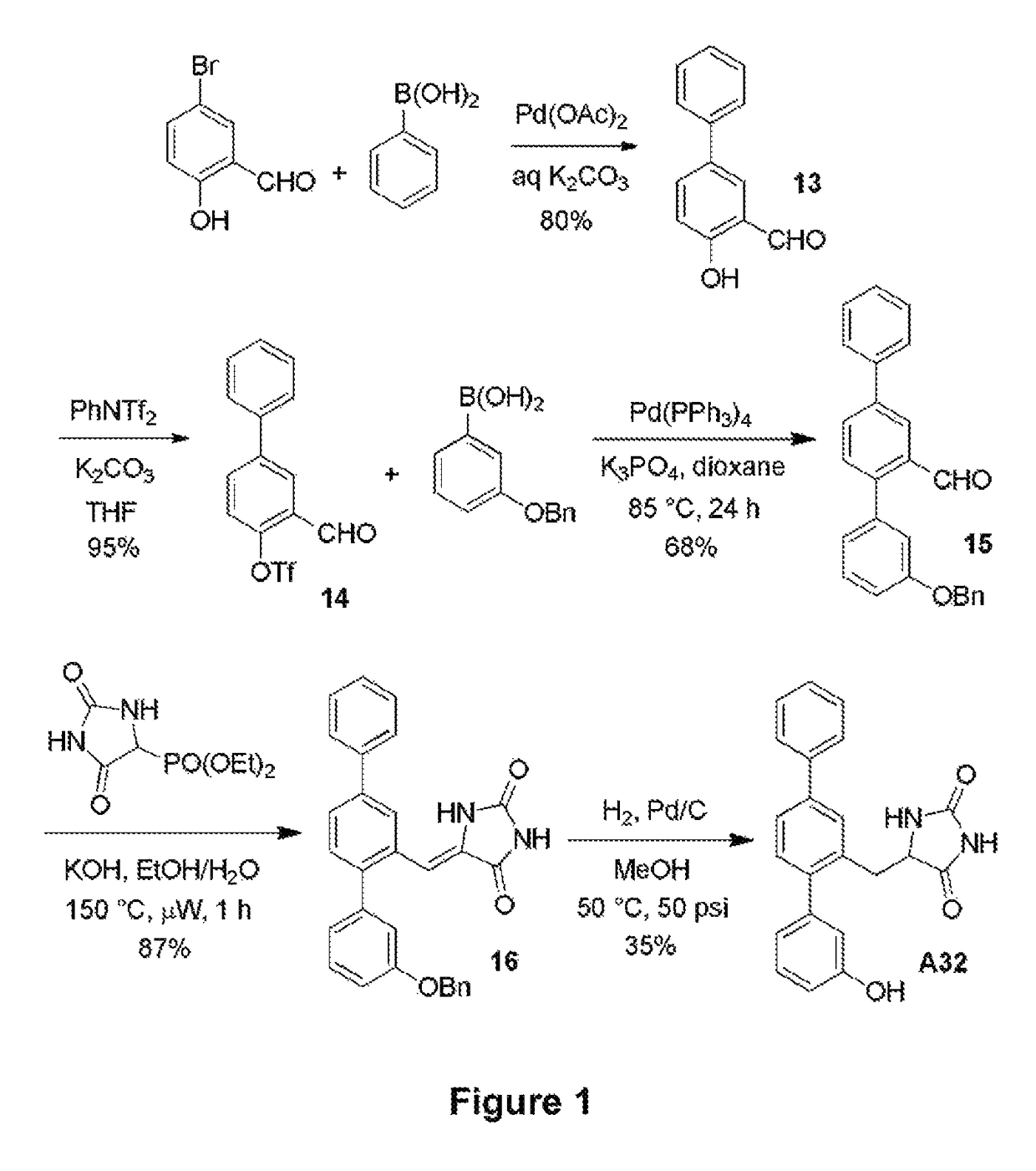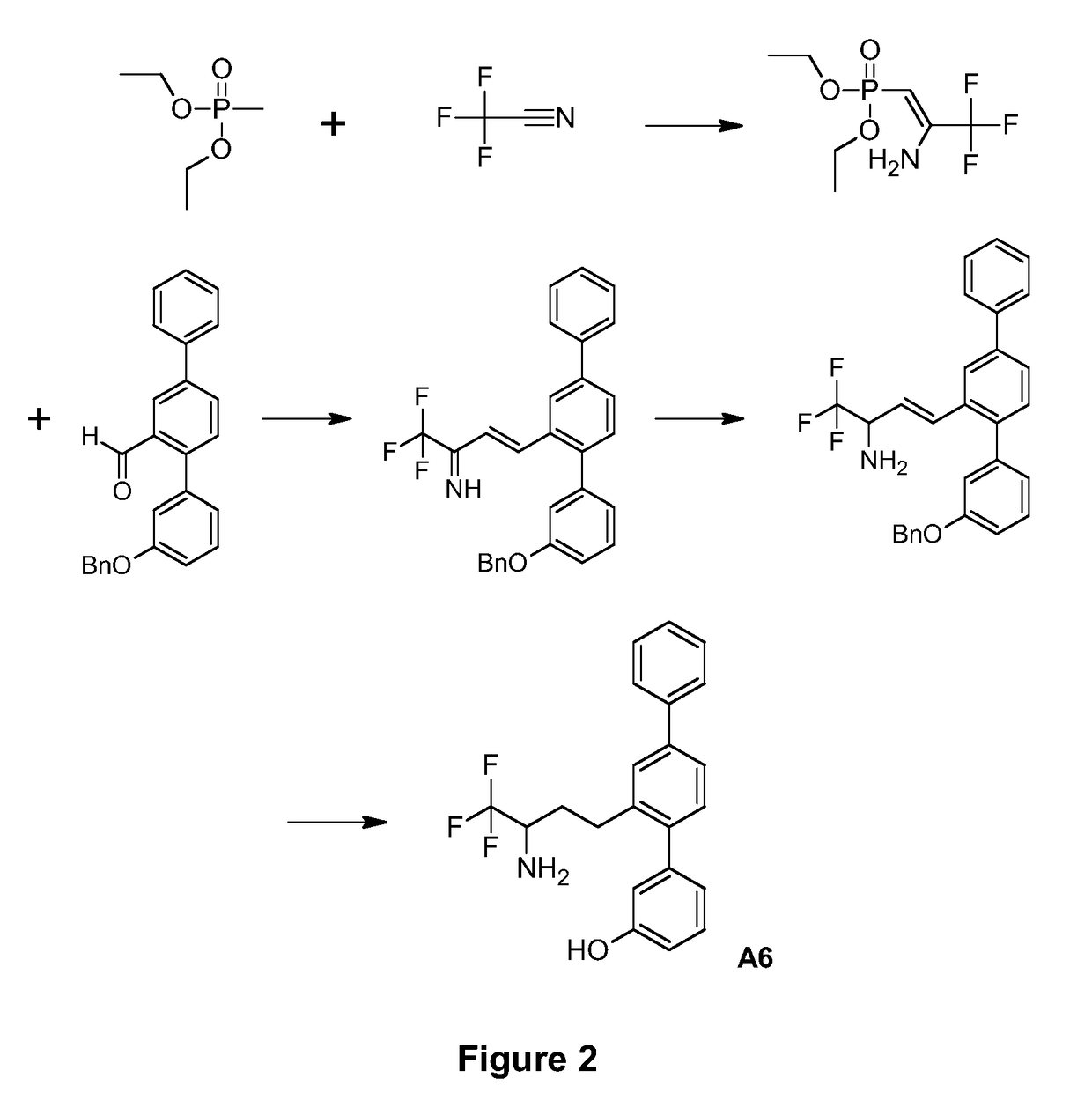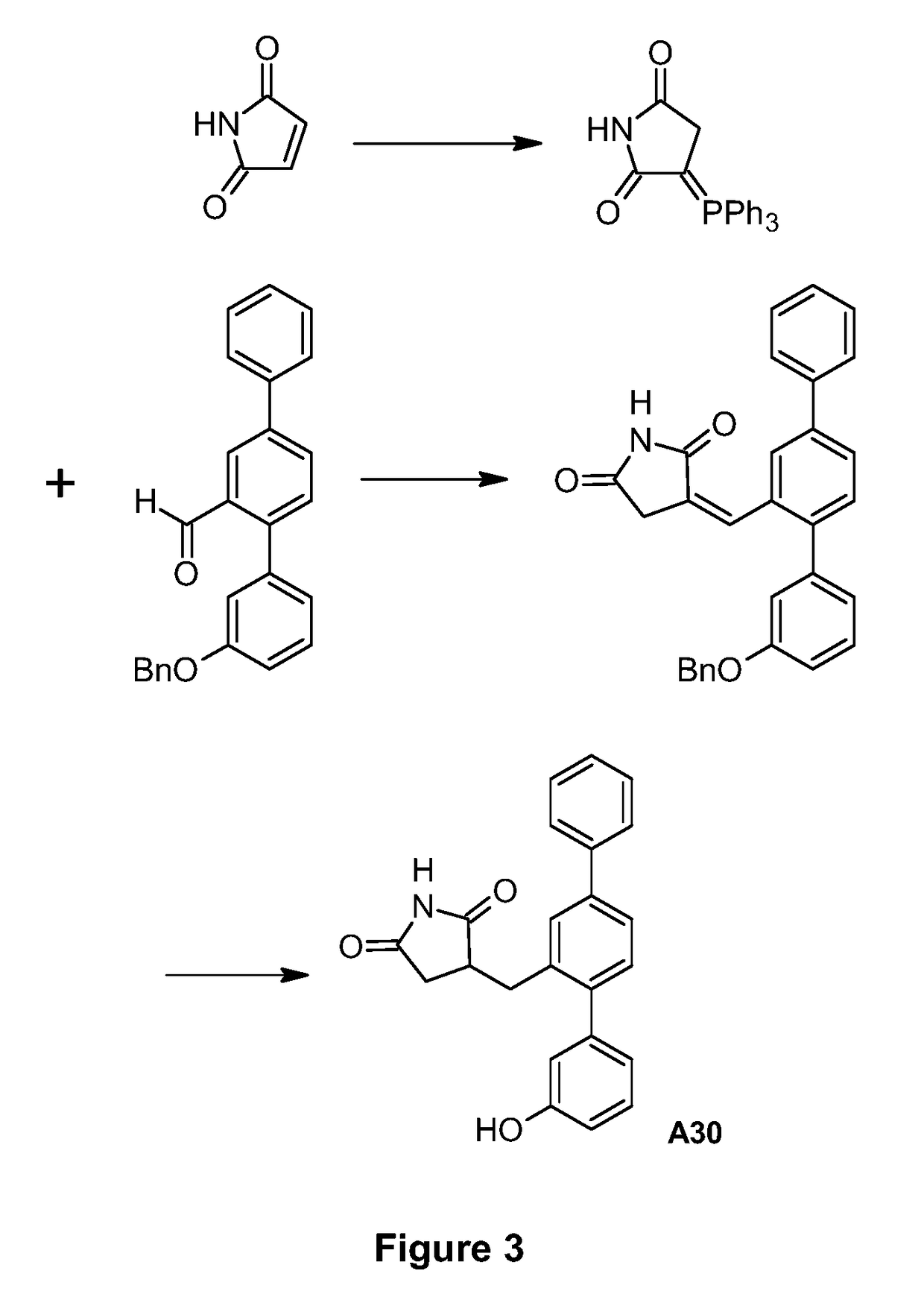Compositions for the treatment of fibrosis and fibrosis-related conditions
a technology for fibrosis and related conditions, applied in drug compositions, metabolic disorders, cardiovascular disorders, etc., can solve the problems of reducing the flexibility of cardiac muscle, and forming permanent scar tissue, so as to prevent, reduce or slow the accumulation of fat in the liver, and preventing, reducing or slowing the death of renal tubular cells
- Summary
- Abstract
- Description
- Claims
- Application Information
AI Technical Summary
Benefits of technology
Problems solved by technology
Method used
Image
Examples
example 1
of A32
[0103]The synthetic route used to prepare A32 is shown in FIG. 1. Briefly, 2-formyl aryl triflate 14 was prepared by means of a Suzuki cross-coupling reaction between 5-bromo-2-hydroxybenzaldehyde and phenylboronic acid to generate 2-hydroxy-5-phenyl benzaldehyde 13, which was subsequently reacted with N-phenyltriflamide. Another Suzuki reaction between 2-formyl aryl triflate 14 and 3-benzyloxyphenylboronic acid yielded terphenyl aldehyde 15, which underwent a Horner-Wadsworth-Emmons (HWE) reaction with diethyl 5-hydantoylphosphonate to form unsaturated hydantoin 16. In the presence of hydrogen and Pd / C, compound 16 underwent simultaneous olefin reduction and phenol deprotection to produce A32.
Production of 2-Hydroxy-5-phenylbenzaldehyde (13)
[0104]5-Bromosalicylaldehyde (2.49 g, 12.4 mmol), phenyl boronic acid (1.51 g, 12.4 mmol), palladium(II) acetate (14 mg, 0.5 mol %) and potassium carbonate (5.14 g, 37.2 mmol) were stirred in degassed water (75 mL) at ambient temperature f...
example 2
of A6
[0110]The synthetic route used to prepare A6 is shown in FIG. 2.
Production of Diethyl [2-amino-3,3,3-trifluoroprop-1-en-1-yl]phosphonate
[0111]A solution of diethyl methylphosphonate (1.000 g, 6.57 mmol) in anhyd. tetrahydrofuran (33 mL) was prepared under nitrogen and cooled in a −80° C. cooling bath. Methyllithium solution, 1.21 M in diethyl ether (5.5 mL, 6.6 mmol) was added dropwise. The mixture was stirred at −80° C. under nitrogen for 1 h.
[0112]Trifluoroacetic acid (0.71 mL, 9.6 mmol) was added dropwise to anhyd. pyridine (11.7 mL, 145 mmol) under nitrogen. The cloudy vapours were cleared under a stream of nitrogen. A 50 mL round bottomed flask was charged with trifluoroacetamide (3.177 g, 33.4 mmol) and dissolved in the pyridine / trifluoroacetic acid mixture under nitrogen. A cannula was inserted into the head space above this solution while the other end of the cannula was inserted into the phosphonate solution. Trimethylacetyl chloride (7.3 mL, 59.3 mmol) was added dropw...
example 3
of A30
[0118]The synthetic route used to prepare A30 is shown in FIG. 3.
Production of 3-(Triphenyl-I5-phosphanylidine)pyrrolidine-2,5-dione
[0119]A suspension of maleimide (3.17 g, 32.7 mmol) and triphenylphosphine (8.56 g, 32.6 mmol) in acetone (165 mL) was heated at reflux under nitrogen for 1 h. The reaction mixture was cooled to room temperature and filtered. The filter cake was washed with acetone (3×20 mL) and dried under vacuum to give the title compound as a white powder (7.21 g, 61%). 1H NMR (400 MHz, DMSO-d6) 9.73 (br. s, 1H), 7.66-7.75 (m, 3H), 7.53-7.65 (m, 12H), 2.89 (s, 2H).
[0120]The filtrates from above were combined and concentrated to remove ca. 120 mL of solvent. The remaining material was heated at reflux under nitrogen for 2 h, allowed to cool to room temperature and filtered. The filter cake was washed with acetone (3×10 mL) and dried under vacuum to give a further crop of the title compound as a white powder (2.63 g, 22%). [Reference: G. Brackman et al., Bioorg. ...
PUM
| Property | Measurement | Unit |
|---|---|---|
| body weight | aaaaa | aaaaa |
| pH | aaaaa | aaaaa |
| mol % | aaaaa | aaaaa |
Abstract
Description
Claims
Application Information
 Login to View More
Login to View More - R&D
- Intellectual Property
- Life Sciences
- Materials
- Tech Scout
- Unparalleled Data Quality
- Higher Quality Content
- 60% Fewer Hallucinations
Browse by: Latest US Patents, China's latest patents, Technical Efficacy Thesaurus, Application Domain, Technology Topic, Popular Technical Reports.
© 2025 PatSnap. All rights reserved.Legal|Privacy policy|Modern Slavery Act Transparency Statement|Sitemap|About US| Contact US: help@patsnap.com



